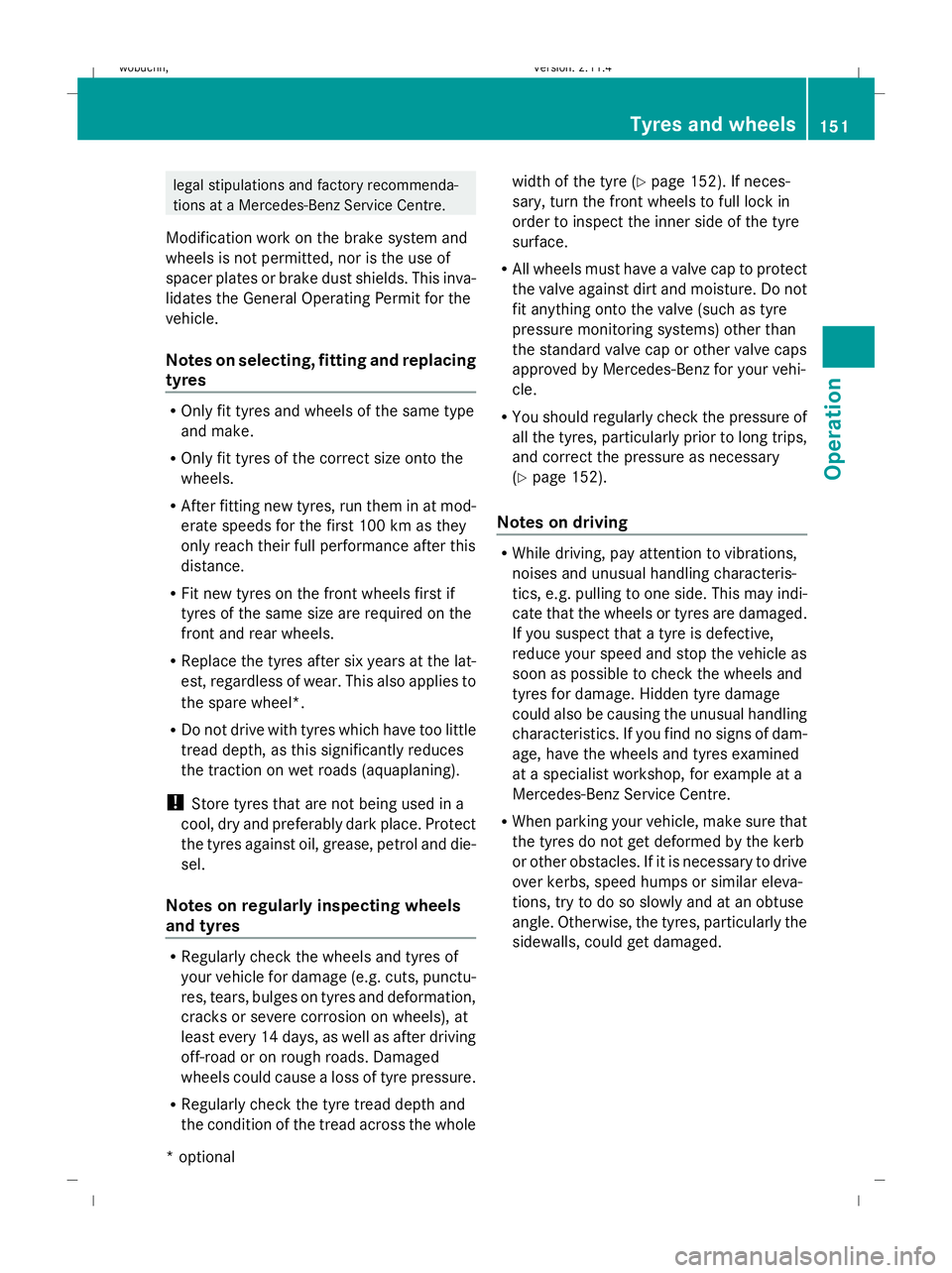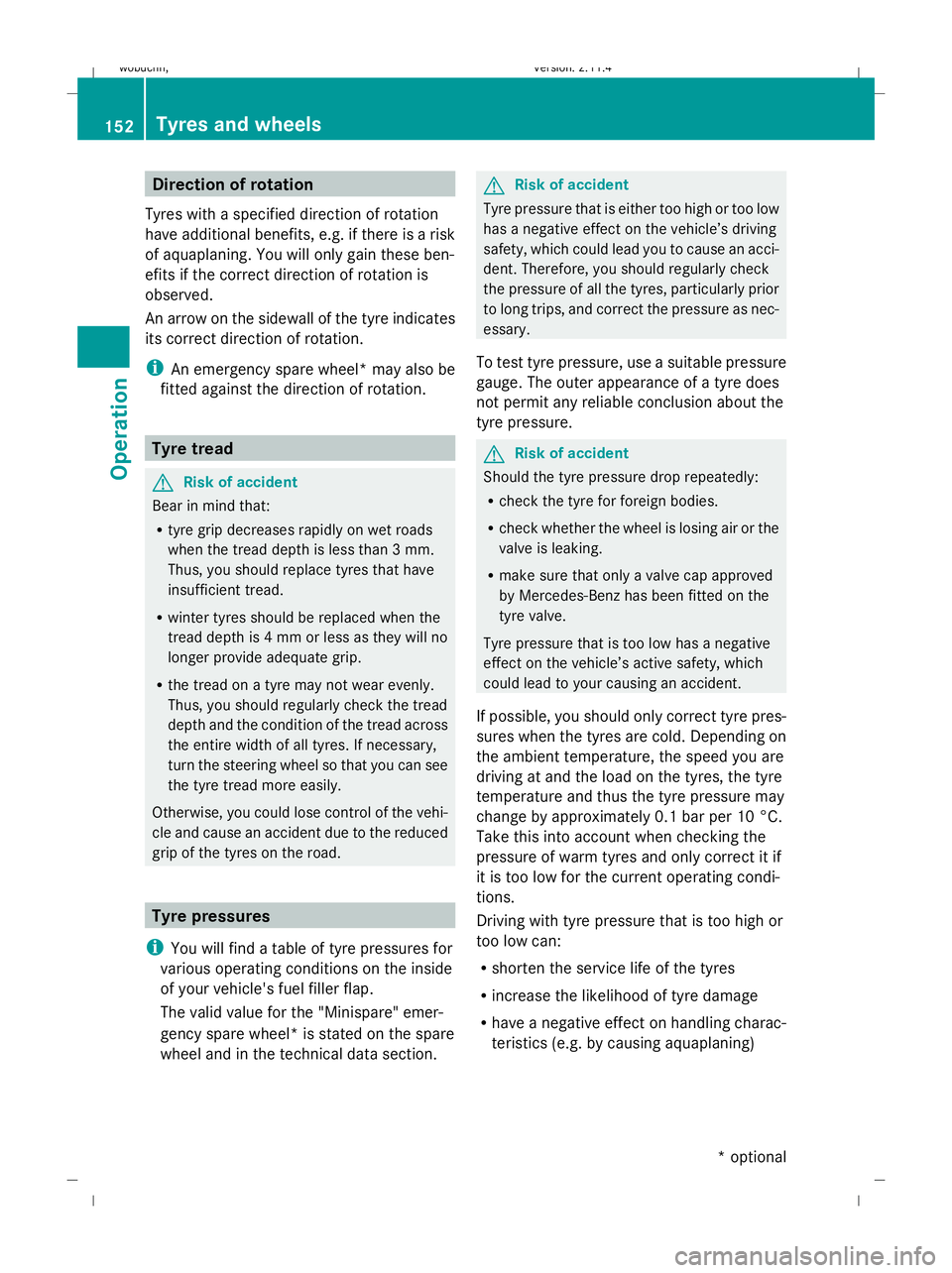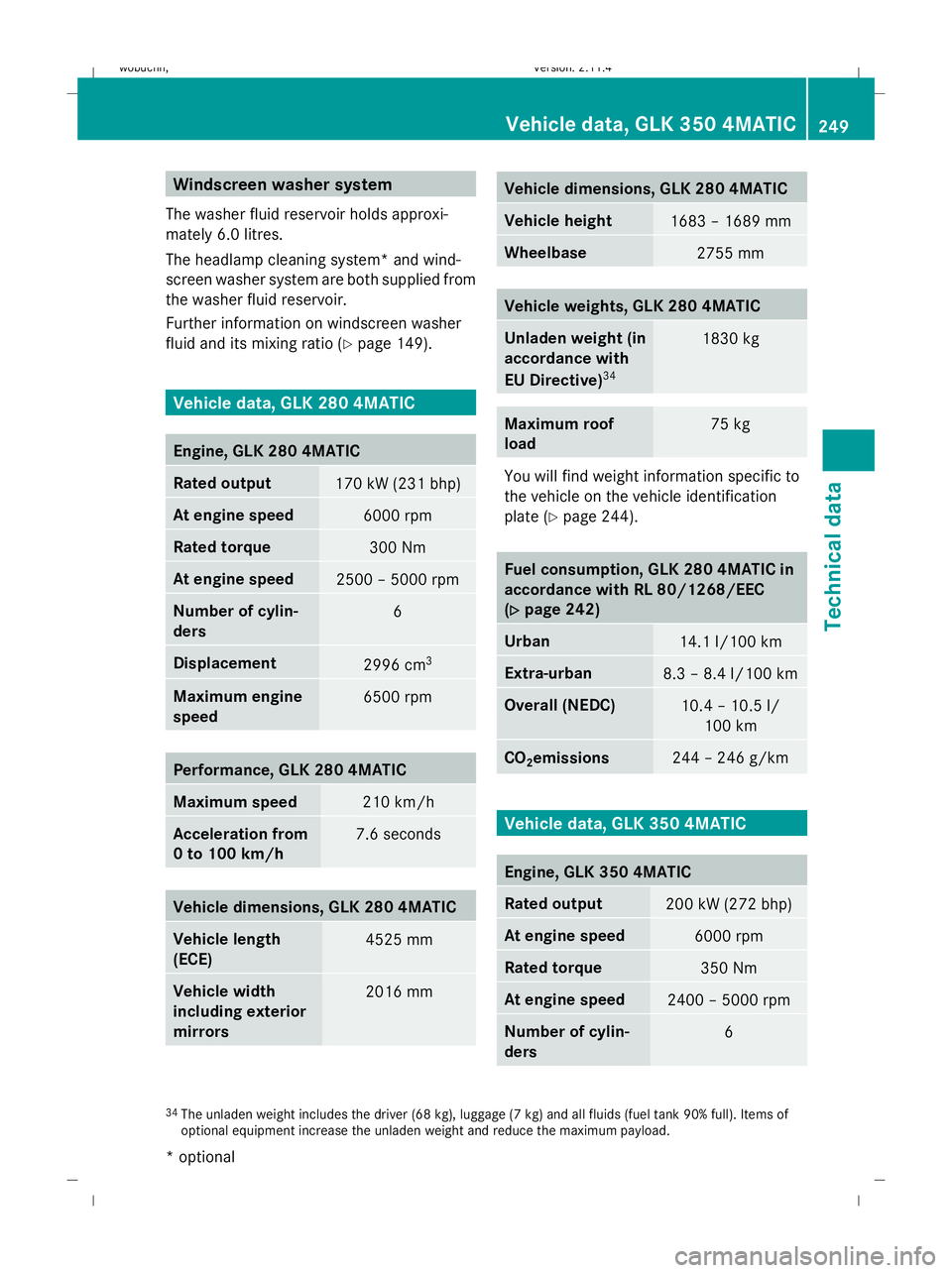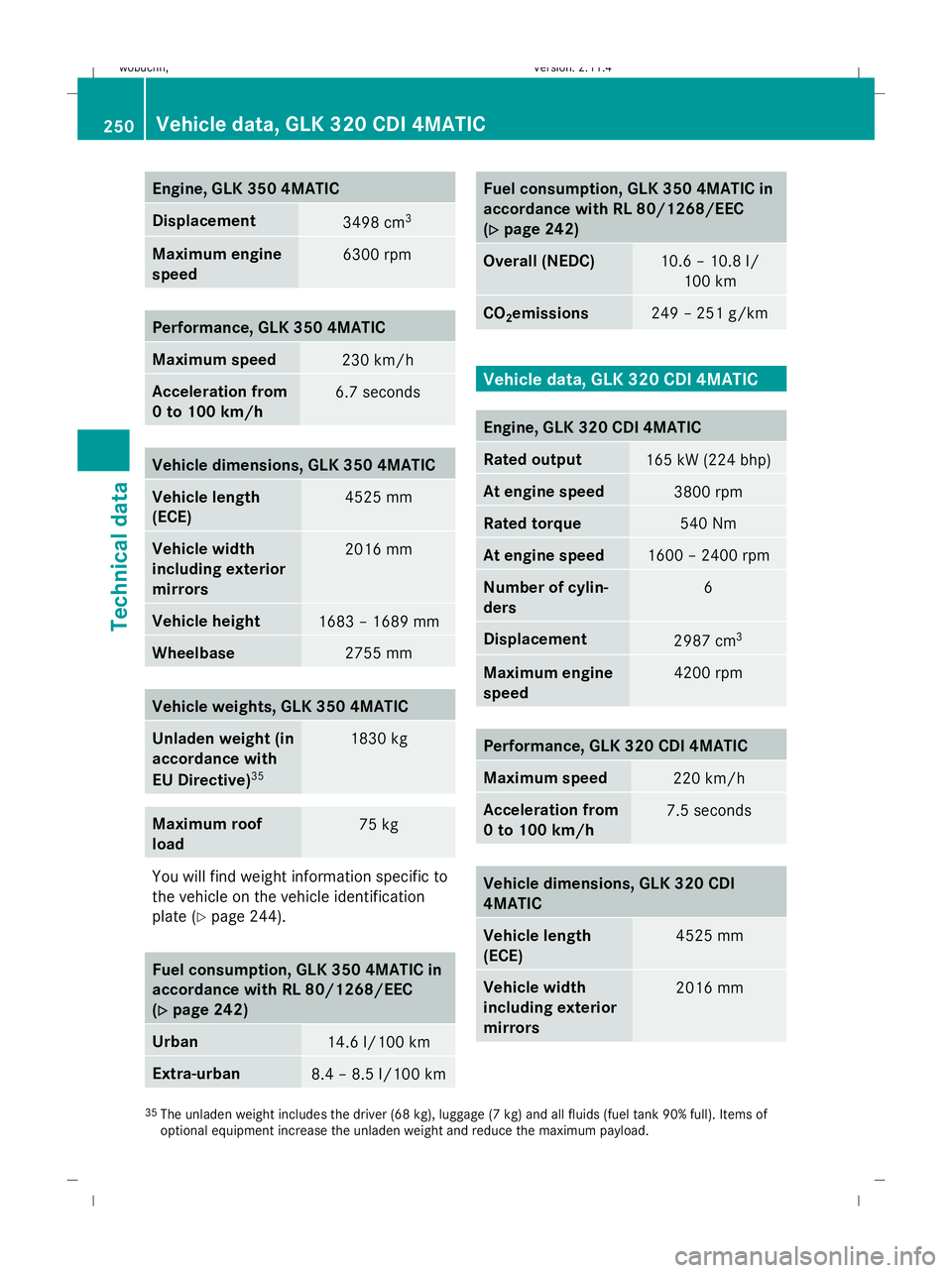width MERCEDES-BENZ GLK SUV 2008 Owners Manual
[x] Cancel search | Manufacturer: MERCEDES-BENZ, Model Year: 2008, Model line: GLK SUV, Model: MERCEDES-BENZ GLK SUV 2008Pages: 261, PDF Size: 8.67 MB
Page 154 of 261

legal stipulations and factory recommenda-
tions at a Mercedes-Benz Service Centre.
Modification work on the brake system and
wheels is not permitted, nor is the use of
spacer plates or brake dust shields. This inva-
lidates the General Operating Permit for the
vehicle.
Notes on selecting, fitting and replacing
tyres R
Only fit tyres and wheels of the same type
and make.
R Only fit tyres of the correct size onto the
wheels.
R After fitting new tyres, run them in at mod-
erate speeds for the first 100 km as they
only reach their full performance after this
distance.
R Fit new tyres on the front wheels first if
tyres of the same size are required on the
front and rear wheels.
R Replace the tyres after six years at the lat-
est, regardless of wear. This also applies to
the spare wheel*.
R Do not drive with tyres which have too little
tread depth, as this significantly reduces
the traction on wet roads (aquaplaning).
! Store tyres that are not being used in a
cool, dry and preferably dark place. Protect
the tyres against oil, grease, petrol and die-
sel.
Notes on regularly inspecting wheels
and tyres R
Regularly check the wheels and tyres of
your vehicle for damage (e.g. cuts, punctu-
res, tears, bulges on tyres and deformation,
cracks or severe corrosion on wheels), at
least every 14 days, as well as after driving
off-road or on rough roads. Damaged
wheels could cause a loss of tyre pressure.
R Regularly check the tyre tread depth and
the condition of the tread across the whole width of the tyre (Y
page 152). If neces-
sary, turn the front wheels to full lock in
order to inspect the inner side of the tyre
surface.
R All wheels must have a valve cap to protect
the valve against dirt and moisture. Do not
fit anything onto the valve (such as tyre
pressure monitoring systems) other than
the standard valve cap or other valve caps
approved by Mercedes-Benz for your vehi-
cle.
R You should regularly check the pressure of
all the tyres, particularly prior to long trips,
and correct the pressure as necessary
(Y page 152).
Notes on driving R
While driving, pay attention to vibrations,
noises and unusual handling characteris-
tics, e.g. pulling to one side. This may indi-
cate that the wheels or tyres are damaged.
If you suspect that a tyre is defective,
reduce your speed and stop the vehicle as
soon as possible to check the wheels and
tyres for damage. Hidden tyre damage
could also be causing the unusual handling
characteristics. If you find no signs of dam-
age, have the wheels and tyres examined
at a specialist workshop, for example at a
Mercedes-Benz Service Centre.
R When parking your vehicle, make sure that
the tyres do not get deformed by the kerb
or other obstacles. If it is necessary to drive
over kerbs, speed humps or similar eleva-
tions, try to do so slowly and at an obtuse
angle. Otherwise, the tyres, particularly the
sidewalls, could get damaged. Tyres and wheels
151Operation
* optional
X204_AKB; 1; 5, en-GB
wobuchh,
Version: 2.11.4 2008-10-15T13:20:56+02:00 - Seite 151 ZDateiname: 6515_0671_02_buchblock.pdf; preflight
Page 155 of 261

Direction of rotation
Tyres with a specified direction of rotation
have additional benefits, e.g. if there is a risk
of aquaplaning. You will only gain these ben-
efits if the correct direction of rotation is
observed.
An arrow on the sidewall of the tyre indicates
its correct direction of rotation.
i An emergency spare wheel* may also be
fitted against the direction of rotation. Tyre tread
G
Risk of accident
Bear in mind that:
R tyre grip decreases rapidly on wet roads
when the tread depth is less than 3 mm.
Thus, you should replace tyres that have
insufficient tread.
R winter tyres should be replaced when the
tread depth is 4 mm or less as they will no
longer provide adequate grip.
R the tread on a tyre may not wear evenly.
Thus, you should regularly check the tread
depth and the condition of the tread across
the entire width of all tyres. If necessary,
turn the steering wheel so that you can see
the tyre tread more easily.
Otherwise, you could lose control of the vehi-
cle and cause an accident due to the reduced
grip of the tyres on the road. Tyre pressures
i You will find a table of tyre pressures for
various operating conditions on the inside
of your vehicle's fuel filler flap.
The valid value for the "Minispare" emer-
gency spare wheel* is stated on the spare
wheel and in the technical data section. G
Risk of accident
Tyre pressure that is either too high or too low
has a negative effect on the vehicle’s driving
safety, which could lead you to cause an acci-
dent. Therefore, you should regularly check
the pressure of all the tyres, particularly prior
to long trips, and correct the pressure as nec-
essary.
To test tyre pressure, use a suitable pressure
gauge. The outer appearance of a tyre does
not permit any reliable conclusion about the
tyre pressure. G
Risk of accident
Should the tyre pressure drop repeatedly:
R check the tyre for foreign bodies.
R check whether the wheel is losing air or the
valve is leaking.
R make sure that only a valve cap approved
by Mercedes-Benz has been fitted on the
tyre valve.
Tyre pressure that is too low has a negative
effect on the vehicle’s active safety, which
could lead to your causing an accident.
If possible, you should only correct tyre pres-
sures when the tyres are cold. Depending on
the ambient temperature, the speed you are
driving at and the load on the tyres, the tyre
temperature and thus the tyre pressure may
change by approximately 0.1 bar per 10 °C.
Take this into account when checking the
pressure of warm tyres and only correct it if
it is too low for the current operating condi-
tions.
Driving with tyre pressure that is too high or
too low can:
R shorten the service life of the tyres
R increase the likelihood of tyre damage
R have a negative effect on handling charac-
teristics (e.g. by causing aquaplaning) 152 Ty
res and wheelsOperation
* optional
X204_AKB; 1; 5, en-GB
wobuchh
,V ersion: 2.11.4
2008-10-15T13:20:56+02:00 - Seite 152 Dateiname: 6515_0671_02_buchblock.pdf; preflight
Page 252 of 261

Windscreen washer system
The washer fluid reservoir holds approxi-
mately 6.0 litres.
The headlamp cleaning system* and wind-
screen washer system are both supplied from
the washer fluid reservoir.
Further information on windscreen washer
fluid and its mixing ratio (Y page 149).Vehicle data, GLK 280 4MATIC
Engine, GLK 280 4MATIC
Rated output
170 kW (231 bhp)
At engine speed
6000 rpm
Rated torque
300 Nm
At engine speed
2500 – 5000 rpm
Number of cylin-
ders
6
Displacement
2996 cm
3 Maximum engine
speed
6500 rpm
Performance, GLK 280 4MATIC
Maximum speed
210 km/h
Acceleration from
0 to 100 km/h
7.6 seconds
Vehicle dimensions, GLK 280 4MATIC
Vehicle length
(ECE)
4525 mm
Vehicle width
including exterior
mirrors
2016 mm Vehicle dimensions, GLK 280 4MATIC
Vehicle height
1683 – 1689 mm
Wheelbase
2755 mm
Vehicle weights, GLK 280 4MATIC
Unladen weight (in
accordance with
EU Directive)
34 1830 kg
Maximum roof
load
75 kg
You will find weight information specific to
the vehicle on the vehicle identification
plate (Y
page 244). Fuel consumption, GLK 280 4MATIC in
accordance with RL 80/1268/EEC
(Y
Y page 242) Urban
14.1 l/100 km
Extra-urban
8.3 – 8.4 l/100 km
Overall (NEDC)
10.4 – 10.5 l/
100 km CO
2emissions 244 – 246 g/km
Vehicle data, GLK 350 4MATIC
Engine, GLK 350 4MATIC
Rated output
200 kW (272 bhp)
At engine speed
6000 rpm
Rated torque
350 Nm
At engine speed
2400 – 5000 rpm
Number of cylin-
ders
6
34
The unladen weight includes the driver (68 kg), luggage (7 kg) and all fluids (fuel tank 90% full). Items of
optional equipment increase the unladen weight and reduce the maximum payload. Vehicle data, GLK 350 4MATIC
249Technical data
* optional
X204_AKB; 1; 5, en-GB
wobuchh,
Version: 2.11.4 2008-10-15T13:20:56+02:00 - Seite 249 ZDateiname: 6515_0671_02_buchblock.pdf; preflight
Page 253 of 261

Engine, GLK 350 4MATIC
Displacement
3498 cm
3 Maximum engine
speed
6300 rpm
Performance, GLK 350 4MATIC
Maximum speed
230 km/h
Acceleration from
0 to 100 km/h
6.7 seconds
Vehicle dimensions, GLK 350 4MATIC
Vehicle length
(ECE)
4525 mm
Vehicle width
including exterior
mirrors
2016 mm
Vehicle height
1683 – 1689 mm
Wheelbase
2755 mm
Vehicle weights, GLK 350 4MATIC
Unladen weight (in
accordance with
EU Directive)
35 1830 kg
Maximum roof
load
75 kg
You will find weight information specific to
the vehicle on the vehicle identification
plate (Y page 244). Fuel consumption, GLK 350 4MATIC in
accordance with RL 80/1268/EEC
(Y Y page 242) Urban
14.6 l/100 km
Extra-urban
8.4 – 8.5 l/100 km Fuel consumption, GLK 350 4MATIC in
accordance with RL 80/1268/EEC
(Y
Y page 242) Overall (NEDC)
10.6 – 10.8 l/
100 km CO
2emissions 249 – 251 g/km
Vehicle data, GLK 320 CDI 4MATIC
Engine, GLK 320 CDI 4MATIC
Rated output
165 kW (224 bhp)
At engine speed
3800 rpm
Rated torque
540 Nm
At engine speed
1600 – 2400 rpm
Number of cylin-
ders 6
Displacement
2987 cm
3 Maximum engine
speed
4200 rpm
Performance, GLK 320 CDI 4MATIC
Maximum speed
220 km/h
Acceleration from
0 to 100 km/h
7.5 seconds
Vehicle dimensions, GLK 320 CDI
4MATIC Vehicle length
(ECE) 4525 mm
Vehicle width
including exterior
mirrors 2016 mm
35
The unladen weight includes the driver (68 kg), luggage (7 kg) and all fluids (fuel tank 90% full). Items of
optional equipment increase the unladen weight and reduce the maximum payload. 250 Vehicle data, GLK 320 CDI 4MATICTechnical data
X204_AKB; 1; 5, en-GB
wobuchh,
Version: 2.11.4 2008-10-15T13:20:56+02:00 - Seite 250Dateiname: 6515_0671_02_buchblock.pdf; preflight